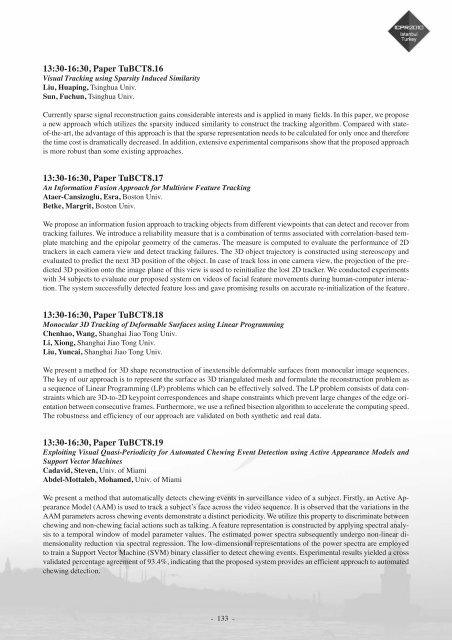Abstract book (pdf) - ICPR 2010
Abstract book (pdf) - ICPR 2010
Abstract book (pdf) - ICPR 2010
- TAGS
- abstract
- icpr
- icpr2010.org
Create successful ePaper yourself
Turn your PDF publications into a flip-book with our unique Google optimized e-Paper software.
13:30-16:30, Paper TuBCT8.16<br />
Visual Tracking using Sparsity Induced Similarity<br />
Liu, Huaping, Tsinghua Univ.<br />
Sun, Fuchun, Tsinghua Univ.<br />
Currently sparse signal reconstruction gains considerable interests and is applied in many fields. In this paper, we propose<br />
a new approach which utilizes the sparsity induced similarity to construct the tracking algorithm. Compared with stateof-the-art,<br />
the advantage of this approach is that the sparse representation needs to be calculated for only once and therefore<br />
the time cost is dramatically decreased. In addition, extensive experimental comparisons show that the proposed approach<br />
is more robust than some existing approaches.<br />
13:30-16:30, Paper TuBCT8.17<br />
An Information Fusion Approach for Multiview Feature Tracking<br />
Ataer-Cansizoglu, Esra, Boston Univ.<br />
Betke, Margrit, Boston Univ.<br />
We propose an information fusion approach to tracking objects from different viewpoints that can detect and recover from<br />
tracking failures. We introduce a reliability measure that is a combination of terms associated with correlation-based template<br />
matching and the epipolar geometry of the cameras. The measure is computed to evaluate the performance of 2D<br />
trackers in each camera view and detect tracking failures. The 3D object trajectory is constructed using stereoscopy and<br />
evaluated to predict the next 3D position of the object. In case of track loss in one camera view, the projection of the predicted<br />
3D position onto the image plane of this view is used to reinitialize the lost 2D tracker. We conducted experiments<br />
with 34 subjects to evaluate our proposed system on videos of facial feature movements during human-computer interaction.<br />
The system successfully detected feature loss and gave promising results on accurate re-initialization of the feature.<br />
13:30-16:30, Paper TuBCT8.18<br />
Monocular 3D Tracking of Deformable Surfaces using Linear Programming<br />
Chenhao, Wang, Shanghai Jiao Tong Univ.<br />
Li, Xiong, Shanghai Jiao Tong Univ.<br />
Liu, Yuncai, Shanghai Jiao Tong Univ.<br />
We present a method for 3D shape reconstruction of inextensible deformable surfaces from monocular image sequences.<br />
The key of our approach is to represent the surface as 3D triangulated mesh and formulate the reconstruction problem as<br />
a sequence of Linear Programming (LP) problems which can be effectively solved. The LP problem consists of data constraints<br />
which are 3D-to-2D keypoint correspondences and shape constraints which prevent large changes of the edge orientation<br />
between consecutive frames. Furthermore, we use a refined bisection algorithm to accelerate the computing speed.<br />
The robustness and efficiency of our approach are validated on both synthetic and real data.<br />
13:30-16:30, Paper TuBCT8.19<br />
Exploiting Visual Quasi-Periodicity for Automated Chewing Event Detection using Active Appearance Models and<br />
Support Vector Machines<br />
Cadavid, Steven, Univ. of Miami<br />
Abdel-Mottaleb, Mohamed, Univ. of Miami<br />
We present a method that automatically detects chewing events in surveillance video of a subject. Firstly, an Active Appearance<br />
Model (AAM) is used to track a subject’s face across the video sequence. It is observed that the variations in the<br />
AAM parameters across chewing events demonstrate a distinct periodicity. We utilize this property to discriminate between<br />
chewing and non-chewing facial actions such as talking. A feature representation is constructed by applying spectral analysis<br />
to a temporal window of model parameter values. The estimated power spectra subsequently undergo non-linear dimensionality<br />
reduction via spectral regression. The low-dimensional representations of the power spectra are employed<br />
to train a Support Vector Machine (SVM) binary classifier to detect chewing events. Experimental results yielded a cross<br />
validated percentage agreement of 93.4%, indicating that the proposed system provides an efficient approach to automated<br />
chewing detection.<br />
- 133 -



